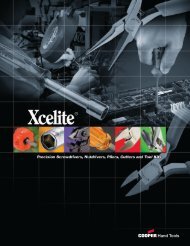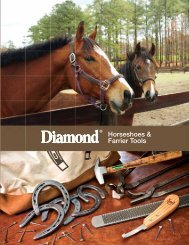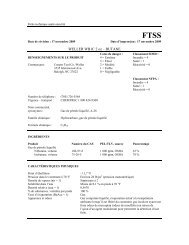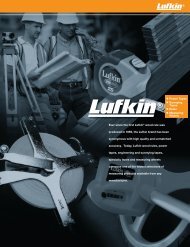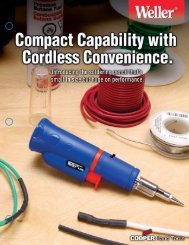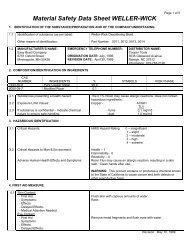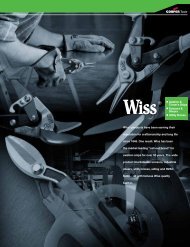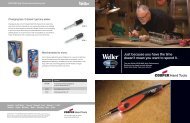THE GUIDE TO FILES AND FILING - Evenfall Studios
THE GUIDE TO FILES AND FILING - Evenfall Studios
THE GUIDE TO FILES AND FILING - Evenfall Studios
You also want an ePaper? Increase the reach of your titles
YUMPU automatically turns print PDFs into web optimized ePapers that Google loves.
<strong>THE</strong> <strong>GUIDE</strong> <strong>TO</strong><strong>FILES</strong> <strong>AND</strong> <strong>FILING</strong>P.O. Box 728 Apex, NC 27502www.cooperhandtools.comCHT06-11103/MW ??????/10M/PRINTED 11/06 USA Cooper No. 550587© 2006, Cooper Industries, LLCSpecifications subject to change without notice.
IntroductionChoosing the right file can be confusing, with somany sizes, shapes and cuts available it is difficultto decide the right one for the job.The range of Nicholson ® files available from CooperHand Tools covers every job task requirement.This booklet has been specially produced to simplifyfile selection and application for any file user.HistoryThe file has been with man now formany years and one of the firstrecordings is in the Bible during thereign of King Saul.This would be approximately 1090BC and at that time files would havebeen used for sharpening varioustypes of primitive tools. From the firstfiles the development and evolutioncan be traced from stone implementsto files with teeth running at rightangles across the file blank to presentday quality machine producedfiles.The first attempt to cut files bymachine was approximately 1490 ADand resulted from an invention byLeonardo da Vinci. However the firstmachine which actually cut files wasthat made by the Frenchman,Chopitel in 1750.At this time files were made frommild material and did not requireannealing. To produce a hardenedsurface various preparations wereused to carburize the file teeth. But itwas the inventions of such men asBernot, Nicholson, Whipple andWeed that provided machines capableof producing better files thanthose produced by hand.How a file is madeToday various kinds of material,product finish and working conditionmake file development anindustrial science. File manufactureinvolves the study of filesteels, file design and file performancefor all file applications.1. File Steel: Is cut to properlength from various width thicknessand cross sections suchas rectangular, square, triangular,round and half round.2. Rough shaping: The blank ispunched to shape or is heatedand forged with drop hammersand rollers to shape the tangand point.3. Annealing: The forged blankis heated to an elevated temperatureand then cooled slowlyunder controlled conditions tosoften the steel for tooth cuttingand to make internal steel structureuniform.4. Final Shaping: The annealedblanks are ground or milled toproduce a surface necessary forthe uniform formation of theteeth. This is followed by drawfilingthat produces the perfectlytrue flat or curved surface necessaryfor the uniform formationof the teeth.5. Forming teeth: The teeth areformed by a rapidly reciprocatingchisel that strikes successiveblows on the file. The hardenedchisel cuts into the softblank displacing and raising thesteel into the desired toothstructure.6. Hardening: The file is thenhardened by heating it in amolten bath to a predeterminedtemperature. This is followed byimmersing the file in a quenchingsolution. This combination ofheating and cooling under carefullycontrolled conditions bringsthe file to the maximum hardnessto the very top of the cuttingedges.7. Finishing: The file iscleaned and sharpened bybead blasting. The tang isreheated to give strengthwithout brittleness. It is thengiven a series of tests bytrained inspectors, and oiledto prevent rust.2 3
File TerminologyEach part of the file has aname and there are many differentshapes and sizes offiles. Furthermore, there arevarying types of file cutsLengthType: The cross-sectionalshape or style of the file i. e.quadrangular, circular, triangularor irregular. These sectionsare further classified accordingto their contours i. e. blunt,taper etc.Blunt: A file whose edges areparallel from end to end and ofconstant width.Taper: The reduction in crosssection of the file from its heelto the point. A file may taperwith width, in thickness or inboth.Coarseness: The number ofteeth per inch length of the file.Cut: The character of the fileteeth with respect to thecoarseness (bastard, secondcutand smooth.)A single-cut file has a singleset of parallel, diagonal rowsof teeth. Single-cut files areoften used with light pressureto produce a smooth surfacefinish or to put a keen edge onknives, shears or saws.A double-cut file has two setsof diagonal rows of teeth. Thesecond set of teeth is cut inthe opposite diagonal direction,and on top of the first set.The first set of teeth is knownas the overcut while the secondis called the upcut. Theupcut is finer than the overcut.The double-cut file is used withheavier pressure than the single-cutand removes materialfaster from the workpiece.available, all with their own names.This section of the booklet will helpyou understand the file and theterms used:Point Belly Heel TangFile TerminologyA rasp-cut has a series ofindividual teeth that areformed by a single-pointedtool. This produces a roughcutand is used primarily onwood, hooves, aluminum andlead.A curved-cut / mill tooth filehas its teeth arranged incurved contours across the fileface and is normally used inautomotive body shops forsmoothing body panels.Plater's Rasp: A rasp filecombination that is used primarilyby farriers in the trimmingof horses' hooves.Woodchuck: A multi-purposeWood chisel / rasp combinationtool used by cabinetmakers,homebuilders, and constructionworkers.Bastard: File coarsenessbetween "Coarse and SecondCut."Back: The convex side of ahalf-round or other similarlyshaped file.Edge: The intersection of twoadjacent faces of the file.Safe Edge: A smooth or uncutedge of the file.Pinning: Filings wedgedbetween the file teeth.Shelling: The breaking of fileteeth, usually caused by usingtoo much pressure reverse filing,filing sharp corners, oredges.Handle: A holder into whichthe tang of the file fits. If thefile has an integral holder thisis known as a solid handle file.4 5
Choosing the right fileTo achieve the desired results it isessential that the right file be usedfor the job. In selecting the rightfile the user should consider theshape, size and coarseness of thefile.The size and the coarseness ofthe file are directly related, so thelarger the file the more stock it willremove and the smaller the file thefiner the finish it will achieve.Most files also have three gradesof cut: bastard-cut, second-cut andsmooth-cut. The coarser the cut ofthe file, the rougher the finish ofthe work. Therefore, the size of thefile and the grade of its cut mustbe taken into account against theamount of stock to be removedand the fineness of fi nish that isrequired.Generally speaking bastard andsecond-cut grades of double-cutfiles would be chosen for the fastremoval of stock while single-cutfiles and smooth double-cut fileswould be chosen for finishing. It ishowever almost impossible to laydown exact guidelines for the rightfile for the job, but using the basicfacts given here the user shouldhave a reasonably clear picture inmind, the nature, size of the work,the kind of finish required, theworking tolerance allowed and therisks (if any) of spoiling the work.In addition to the amount of stockto be removed, the contour of itsremoval is equally important and isdetermined by the shape of the file.For example, a triangular fileshould be used on acute internalangles, to clear out square cornersand in sharpening saw teeth.A flat file should be used for general-purposework, a square file forenlarging rectangular holes and around file for enlarging round holes.A half-round file can be used fordual purposes, the flat face for filingflat surfaces and the curved facefor grooves.How to use a file correctlyFiling is an industrial art - grip,stroke and pressure may vary, tofit the job. There are three elementalways a file can be put to workThey are:Straight filing: This consists ofpushing the file lengthwise-straightahead or slightly diagonally-acrossthe workpiece.Drawfiling: This consists of graspingthe file at each end, pushingand drawing it across the workpiece.Lathefiling: This consists ofstroking the file against workrevolving in a lathe.For normal filing, the vice shouldbe about elbow height. Whenthere is a great deal of heavy filingit is better to have the work slightlylower. If the work is of fine anddelicate nature, the work can beraised to eye level.For work that could become damagedin the vice through pressure,a pair of protectors made of zinc,copper or aluminum sheet shouldbe used between the workpieceand vise jaws.The GripFor files needing two-handedoperation, the handle should begrasped in one hand and the pointof the file in the other hand.The file handle should be rested inthe palm with the thumb pointingalong the top of the handle andthe fingers gripping the underside.The point of the file should begrasped between the thumb andthe first two fingers with the thumbbeing on the top of the file.When heavy filing strokes arerequired, the thumb on the point isnormally in line with the6 7
file; the tip of the thumb pointedforward. For lighter strokes however,the thumb can be turned to asmuch as right angles to the directionof the strokeIf the file is being used one-handedfor filing pins, dies or edgedtools not being held in a vise, theforefinger, and not the thumb isplaced on top of the handle in linewith the file.Carrying the fileFor normal flat filing, the operatorshould aim to carry the file forwardon an almost straight line in thesame plane, changing its courseenough to prevent grooving. Toomuch pressure often results in arocking motion causing a roundedsurface.Keep the file cuttingOne of the quickest ways to ruin agood file is to apply too muchpressure, or too little, on the forwardstroke. Different materials ofcourse require different touches;however, in general, just enoughpressure should be applied tokeep the file cutting. If allowed toslide over the harder metals theteeth of the file rapidly becomedull, and if they are overloaded bytoo much pressure, they are likelyto chip or clog.On the reverse stroke, it is best tolift the file clear of the workpiece,except on very soft metals. Eventhen pressure should be very light,never more than the weight of thefile itself.DrawfilingDrawfiling consists of grasping thefile firmly at each end and alternativelypushing and pulling the filesideways across the work. Sincefiles are made primarily to cut on alongitudinal forward stroke, a filewith a short-angle cut shouldnever be used, as it will score andscratch instead of shaving andShearing. When accomplishedproperly, drawfiling produces afiner finish than straight filing.Normally, a standard Mill Bastardfile is used for drawfiling, butwhere a considerable amount ofstock has to be removed, a Flat orHand file (Double Cut) will workfaster. However, this roughingdown leaves small ridges that willhave to be smoothed by finishingwith a Single Cut Mill file.Lathe filingWhen filing work revolving in alathe, the file should not be heldrigid or stationary, but stroked constantly.A slight gliding or lateralmotion assists the file to clearitself and eliminate ridges andgrooves.While a Mill file is capable of goodlathe filing, there is a special LongAngle Lathe file with teeth cut at amuch larger angle. This provides acleaner shearing, self-clearing file,eliminates drag or tear, overcomeschatter and reduces clogging.Uncut edges on this file protectany shoulders on the work, whichare not filed, and the dog, whichholds the workpiece.Lathe filing is usually employed forfitting shafts. Where stock is to beremoved, a 12"/300mm or14"/350mm Long Angle Lathe fileis preferable. This file will providethe finish suitable for a drive fit.For a running fit a Mill file will providea smooth finish. Where8 9
a fine finish is required a SwissPattern and or Pillar file in No. 4should be used.Recommended Surface Feet perMinute for Lathe Filing:Cast Iron Approximately 150and filing in the correct manner. Allthings being correct, a smooth cuttingaction and a good clean finishon the work is achieved. If there isstubborn resistance, chances arethe wrong file is being used, thefile is damaged or the wrongmethod is being used.Annealed Tool Steel Approximately 175Machinery Steel Approximately 350Soft Yellow Brass Approximately 500Many lathe filers make a practiceof not using a new file for workrequiring an extremely fine finish.In using the Long Angle Lathe file,care should be taken at shaft endsas this fast cutting file may cut toodeeply.Do not run a hand over lathe work,as oil and moisture can coat thesurface and make it difficult for thefile to take hold. For lathe workthat has oval, ecliptical or irregularlyround form, the finer SwissPattern files are most satisfactory.Filing different metalsDifferent metals vary greatly incharacter and properties, someare softer than others are, andsome are more ductile and so on.The nature of the metal has to betaken carefully into account whenchoosing the right file and applyingit to the job. For instance, asoft ductile metal requires a keenfile and only light pressure mustbe applied during filing if the workis not to be deformed. Conversely,a hard and less ductile metal mayrequire a file with duller teeth toavoid them biting too deep andbreaking off when pressure isapplied.When filing a material the usercan normally feel whether or nothe is using the right file,Filing rough castingsSnagging castings, removing fins,spurs and other projections, ishard on normal files. Their teethare for fast cutting and do not possessthe ruggedness for drivingagainst hard projections andedges. This filing engages only afew teeth, thus putting a strain oneach. For such work, it is better touse a Foundry file with sturdierteeth and heavy-set edges toresist shelling or breaking out.Filing die castingsLike foundry castings, die castingsusually have sharp corners, webs,fins or flashing which are liable todamage a normal file. In addition,die castings consist of magnesium,zinc, aluminum, alloy or similarcombinations of metal whichhave the tendency to clog regularfiles.Depending on the shape, CooperHand Tools has a variety of filesthat will meet the required application.Suggested files are found inthe "job by job" file selector of thisbook, or you may contact yourCooper Hand Tools CustomerService Representative.10 11
Filing stainless steelThe use of stainless steel andalloy steels has created other filingtechniques. These steels with hardchromium and nickel content aretough and dense. This causesthem to be abrasive, which shortensthe life of the normal file.To overcome these problems, fileshave been developed with goodwearing qualities. These files,when used with a light pressureand a slow, steadyStroke, will remove metal and providea good finish.Filing aluminumAluminum is soft and is difficult tofile, file teeth clog even undermoderate pressure. Filing aluminumis divided into:1) Filing roughness from aluminumcastings,2) Filing sheet and bar aluminum,3) Filing aluminum alloys.To produce a good finish, theAluminum Type A file has beendeveloped. The file upcut is deepwith an open throat, the overcutfine which produces small scallopson the upcut. This breaks up thefilings and allows the file to clear.This also overcomes chatter andprevents too large a bite. By usinga shearing stroke toward the left, agood finish can be obtained.Filing brassBrass is difficult to file because itis softer than steel, but tough. Thisdemands teeth that are sharp,sturdy and cut to prevent groovingand running the file off the work.The Brass file has a short upcutangle and a fine long angle overcutwhich produces small scallopsto break up filings and enable thefile to clear. With pressure, thesharp high-cut teeth bite deep,with less pressure, the short upcutangle smoothes.Filing Bronze (Copper, tin or other alloying elements}Bronze is similar in nature to brassin some aspects, but variesaccording to the percentages ofalloying elements.Average sharpness of the file issatisfactory for some bronzes,while for others, a file that canmaintain its sharpness for longerperiods is required. Thus, for theharder bronzes, a file with a moreacute angle at the top of the toothis desirable. This is known as athin topped tooth.The direction of stroke of the fileshould be crossed frequently toavoid grooving with bronze andbrass.Filing Wrought IronWrought iron is relatively simple tofile. It is soft but only moderatelyductile so it is not necessary for afile to be very sharp to obtaingood results.Filing plasticsHard plastics are dense and brittle,and material is removed aslight powder. The abrasiveness ofhard plastics requires files withhigh sharp teeth. Soft plastics arefiled in shreds so Shear Tooth filesshould be used for thisapplication.Depending on the density of thematerial, Cooper Hand Tools hasthe file that will meet the requiredapplication. Suggested files arefound in the "job by job" file selectorof this book, or you may contactyour Cooper Hand ToolsCustomer Service Representative.12 13
Filing soft materialsSoft materials such as Aluminum,Brass, Copper, Plastics hard rubberand Wood, a Shear Tooth fileprovides fast material removal withgood smoothing qualities. Thecombination of the Single Cut andthe Long Angle helps the ShearTooth file to clear. Because of theLong Angle the file has a tendencyto run to the left on narrow surfaces.This can be overcome by filingwith a diagonal stroke to theright.Precision filingFor filing such as that employed bythe instrument industry, there is arange of Swiss Pattern files. Thedelicate precision work calls forthese files be made to exactingmeasurements and finer cuts.The flat Precision file should beused with a slow smooth strokemoving the file laterally along thework on the forward stroke. Inusing Round or Half Round types,the filing should be clockwise toensure a deeper cut and asmoother finish.Saw FilingEfficient saw filing demands, firstof all, a steady hand and a goodfile. Also, the file must be correctin design, cut and size for the typeof saw and the type of teeth to befiled.The stroke must be absolutelylevel, as the slightest rocking willaffect the cutting edge of the sawtooth.The file must be lifted off thework when drawing back for thenext stroke.used, to be sure there is no chatteror vibration in the saw. This willshorten the life of the file.Sharpening hand sawsHandsaws of two types, theCrosscut and the Rip must bereset, normally every fourth or fifthfiling. Check that teeth are ofequal height. This can be accomplishedby passing the file lightlylengthwise along the tops of theteeth. Some may be flattened, othersare hardly touched. The flattenedteeth will require more filingto put them in shape.These files should be used:The teeth have to be set at thecorrect angle in relation to eachother. This is best done with a"Saw Set" usually before filing.However, some filers prefer to dothis after the saw has been filed.To file saw teeth, provisions mustbe made to hold the saw. A sawvise should be14 15FiveFive and a halfSixSevenEightNineTen7"/175mm Regular Taper or 6"/150mm Heavy Taper7" /175mm Regular Taper or 6" /150mm Heavy Taper7" /175mm or 8" /200mm Slim Taper6" /150mm, 7" /175mm Slim Taper and9" /225mm or 10" /250mm Double Ender6" /150mm Slim Taper or 7" /175mm Extra SlimTaper or 9"/225mm Double Ender or8"/200mm Double Extra Slim Taper6" /150mm Extra Slim Taper, 7"/175mm DoubleExtra Slim Taper or 8"/200mm Double Ender5" /125mm or 6" /150mm Extra Slim Taper,6"/150mm Double Ender
Filing chain saw teethRounded hooded chain saws:These type of chain saws requireRound Chain saw files specificallydesigned for the task. These filesare available in various diametersto fit a sizes of Round Hoodedchain saws. Place the file againstthe beveled cutting surface of theteeth that face both sides and providetheir own clearance at anangle of 20∞ to 45∞ with the sawblade, depending on manufacturersspecifications. The direction ofthe filing stroke is off the cuttingedge. It is essential that the file beheld level and it should be pressedback and slightly up during the filingstroke. Every other tooth isfiled, and then the chain saw isreversed. The depth gauges of thistype of saw control the depth ofthe cut that the saw will take. Asthe cutting teeth are sharpened,they become lower, and it is necessaryto lower the depth gaugesan equal extent. The difference inheight between cutting teeth anddepth gauge should be between020"/ 5mm and 030"/ 75mm.File the depth gauge only asrequired to maintain dimensionsbetween cutter and gauge as cutteris filed back. Do not file off toomuch. This overloads motor andchain and the chain will clog. Usea depth gauge, chainsaw file, or amill file.Sharpening circular sawsBefore removing the saw bladesfrom saw, lower the blade untilonly 1/64" (4mm) protrudes abovethe table. Place a file over theopening in the table and by hand,revolve the saw backward againstthe file. Be sure that the file toucheseach tooth top. Remove thesaw blade and sharpen, using thefollowing:6"/ 150mm and 7"/175mm sawsuse 6"/150mm Cantsaw file.8"/200mm and 9"/225mm sawsuse 8"/200mm Cantsaw file.10"/250mm and up use10"/250mm Cantsaw file.Some large size circular saws maybe sharpened without removingthem from the saw as long asthere is no chatter. Large circularsaws with insert type teeth aresharpened with a Mill file. Thelarger the saw, the larger the file.Filing the hand crosscut sawThe teeth of the crosscut saws cutwith their edges and points: edgesmust be beveled and sharp. Startat the point of the saw and worktowards the handle. Place the filein the gullet to the left of the firsttooth set away from you. Hold thefile level with the angle of the sawblade. At this angle, it shouldtouch on the bevels of both teeth.When filing the flattened teeth,only half should be filed away at atime. Miss the next gullet and filethe one following until every othergullet has been filed.Reverse the saw and beginprocess from second gullet awayfrom saw point.Filing hand ripsawsFor pointing and filing, follow thesame procedure as the Crosscutsaw. It must be remembered thatthe Rip saw is filed so that thetooth points do the cutting, not theedges. Teeth should be filed atright angles to the blade. Everyother tooth is brought to a squareedge, the saw is reversed and theremaining teeth filed.Sharpening crosscut sawsThe Crosscut saw has two typesof teeth, cutters and rakers. Thecutters do the cutting, the16 17
akers clear the cut. This is filed atan angle of 45° from the filer. Thispermits access to cutters andenables the teeth to be filed at thecorrect angle.Teeth should be checked for levelness,the raker teeth beingbetween 1/100"/25mm to1/64"/.4mm below level of cuttingteeth. The filer should use aCrosscut Saw file or a Mill file andfile all cutter teeth to a point. Thesaw is placed vertically and the fileused across the rakers. Should thegullets of the teeth require deepening,a Round file or a Mill filewith round edge can be used, oruse the back of the Crosscut file.Sharpening tools and implementsThere are many tools and implementsin industry, agriculture andgardening thatrequire regular sharpening. Suchtools may be filed towards or awayfrom the edge, the former for theearly part of the task and the latterfor the light finishing touches. Forcoarse steel cutting edges forhoes, ploughs etc., Home andGarden files, as well as Axe andHandy files are available. Forharder carbon steels in cutterknives, shears etc., the SecondCut or Smooth Mill provides asure, but smoother bite. It isessential that the work glaze beremoved in the first few strokes, soapply extra pressure in very slow,deliberate strokes at the beginning.RaspsRasps are broadly classified aswood, cabinet and horse Rasps.Also available are rasp combinationsknown as Four-in-Hand (orShoe Rasp) and Wood Craft Rasp.The Wood Rasp is a coarser cutthan the Cabinet Rasp andis made primarily for the rapidremoval of stock. For finer woodwork,the Cabinet Rasp provides ameans of bringing mortise-andtenonjoints to a proper fit. TheHorse Rasp is used for shoeinghorses. The Plater's Rasp is availablefor light hooves such as racehorses.WoodchuckWoodchuck rasp is a chisel / raspcombination tool used for a varietyof wood working tasks. Each toolfeatures a flat wood rasp on oneside and a half-round wood raspon the other. There are edge teethfor those hard to get spots. Thechisel point features an extremelysharp, polished and ground blade.Care of the fileThe teeth of the file should be protectedwhen the file is not in useby hanging it in a rack or keepingit in a drawer with wooden divisions.Files should always be kept clearof water or grease, since thisimpairs the filing action. It is advisableto wrap the file in a cloth forprotection when it is carried in atoolbox.The file teeth should be kept cleanat all times by using a file card, ora wire file brush, to clear thegrooves between the teeth.SafetyFor safety reasons, a file shouldnever be used without a tightfitting handle. Serious accidentscan result if the handlebecomes detached exposing thesharp point of the tang.Cooper Hand Tools offers a varietyof different size file handles producedin traditional wood, or frommodern plastics. If you need helpin selecting which handle is rightfor your file, contact your CooperHand Tools Customer Service18Representative today.19
'Job by Job' file selector'Job by Job' file selectorAluminum alloy Flat Bastard File, Aluminum File, Magicut ®Auger BitAuto BodyBabbittAuger Bit FileBodifilesBearing, brass Magicut ®Flat Babbitt, Super Shear ® , Flat FilesBearing, bronze Flat Bastard File, Magicut ®BevelingBlacksmithBolt threadsFlat Bastard, Mill FileRasp and Flat Bastard, Half-Round Bastard,Flat Coarse FileTaper, Mill or Knife File, Mill BastardBrass Flat Bastard File, Magicut ® , Super Shear ®Bronze Flat Bastard File, Magicut ®Cabinet, woodCast ironCasting roughContact pointsCabinet File, Cabinet Rasp or WoodchuckFlat, Half-Round, Square or RoundFile, according to shape of materialFlat Bastard FileMill Bastard, Second Cut, and Tungsten Point FilesCopper Flat Bastard File, Magicut ®Cutter,Machine toolThis tool is generally ground and sharpened byan emery wheel. Can be filed only when in an annealedcondition. Use file to suit shape or surface.Die shopElectricConnections(cleaning)Fender, autoFiberFine workFinishingFoundry castingFurniture, makingGarden ToolGroovingHard rubberHoleHorse-shoeingHot metal, filingIronSwiss Pattern Files of appropriate shapeIf surface is large, use Mill BastardFile, otherwise use Tungsten point.BodifilesFlat Bastard File or RaspSwiss Pattern FilesMill Bastard File. For lathe filing, useMill Bastard File or Long Angle Lathe FileFlat Bastard FileCabinet File, Cabinet Rasp, or Mill Bastard FileHome and Garden FileSquare Bastard, Round Bastard,Half-Round Bastard, or Slim Taper,according to shape of grooveFlat Bastard FileRound Bastard File or Square Bastard FileHorse Rasp, Plater's RaspFlat Bastard FileBastard-Cut File according to shape of materialCutter, millingDe-scalingDie blockDie castingDie forgingSee Cutter, Machine toolFlat Bastard FileFlat Bastard FileFlat Bastard File, Half-Round Bastard File, RoundBastard File, Square Bastard File, or Mill BastardFile, according to shape of the die casting and finishdesired.Flat Bastard File or Half Round Bastard File,according to shape of the die forging.Joint, mortise andtenonKey wayKeys, filingKnifeLathe-turnedSectionLaminateCabinet File or Cabinet RaspSquare Bastard or Pillar Bastard FileWarding Bastard FileMill FilesMill Bastard File or Long Angle LatheFileLaminate File, Plastic File, Mill Bastard File20 21
'Job by Job' file selector'Job by Job' file selectorLawn mowerLock, mendingMachinists' workMillwrights' workMill Bastard File or Home and Garden File.Warding Bastard File.Machinists' File such as Flat, Half Round, Square orRound. Also Mill or Tapers, in cuts according to work.Flat, Half-Round, Round, Square Mill Files.Steel alloyUse file applicable to the shape of the material.File steel alloy only when it is annealed.Switch contacts Contact Point File or Mill Bastard File, according tosurface area of switch contacts.Switch, electricMill Bastard File or Contact Point File, according tosize of switch.Model, metalMolded partNotchSwiss Pattern Files.Flat Bastard File or Mill Bastard File.Taper or Knife File.TemplateV-grooveFiles, including Flat Bastard File, Half-Round BastardFile, Mill Bastard File, or Round Bastard File.Files, including Knife, Taper, Slim Taper,X Slim Taper, XX Slim Taper.Ornaments, woodMakingFiles, including Cabinet File, CabinetRasp. Round Bastard Mill Bastard.and Slim Taper File.Wood workingZincCabinet File or Cabinet Rasp.Babbit File.Pattern making,WoodPipe fittingPlaner knifecarbon steelPlasticsFiles, including Cabinet File, CabinetRasp, Pattern Makers Rasp, Woodchuck,Round Bastard, Square Bastard, MillBastard and Slim Taper File.Half-Round Bastard File.Mill Bastard File.Flat Bastard File. Also Mill Bastard File, Plastics File,Laminate File, sharpened for plastics.SAWSBand SawCant SawChain SawCircular SawCross-Cut SawBand Saw Taper Single-Cut FileCantsaw or Mill Bastard File.Round, Special Square, Lozenge File* (Special Mill Filefor Depth Gauge)Mill Bastard, Cantsaw and Slim Taper FilesSpecial Crosscut, Mill, Round, or Round Edge Mill File.Plumbers' workRotary mowerBladeRough filingSlotSnaggingSoft metalStainless SteelHalf-Round Bastard.Home and Garden File, Handy File,Flat Bastard.Bastard File depending on shape to be filed.Knife File, Slim Taper or Warding.Flat Bastard File.Flat Bastard.Flat, or Mill File sharpened for stainlessHand SawWood orBuck SawSlim Taper, Extra Slim Taper, or Double Extra Slim TaperFile, according to points of saw. File recommended forsaw points per inch. Saw points shown in Bold.5 - 7" Regular Taper5 1/2 - 7" Regular Taper6 - 7" or 8" Slim Taper7 - 7" or 8" Slim Taper8 - 6" Slim Taper, 7" Extra Slim Taperor 8" Double Extra Slim Taper9 - 6" Extra Slim Taper or 7" Double Extra Slim Taper10 - 5" or 6" Extra Slim TaperMill Bastard and Slim Taper FilesSteelFlat Bastard File.22 23
Profile Selector for Machinist’s FilesCross Section Name ShapeCharacter of Teeth Taper General UsesFlatHandPillarWardingSquareThree SquareRoundHalf RoundRectangularRectangularAlmost squareThinSquareTriangularCircularThird-CircularUsually bastard. Also Taper in width A general purposesecond-cut and smoothfileOne-edge safe. Bastard Uniform in Finishing flatsecond-cut and smooth width surfacesOne-edge safe. Bastard Uniform in Keyways, slotssecond-cut and smooth width narrow workUsually bastard. Also Width sharply Filing ward notchessecond-cut and smooth tapered in keys. NarrowthicknessworkuniformBastard, second-cut and Tapered Enlarging holes orSmoothrecesses Mortises,keyways and splinesSharp edges. Bastard Tapered Filing acute angles,second-cut and smoothcorners, grooves,notchesUsually bastard. Also Either tapered Enlarging holes;second-cut and smooth ("Rat Tail")* shaping curvedor bluntsurfacesUsually bastard. Also Uniform in Concave cornerssecond-cut and smooth width crevices, roundholesKnifeKnife-ShapedProfile Selector for Special Purpose FilesAluminum Flat RectangularUsually bastard. Also Tapered Cleaning out acutesecond-cut and smooth curving to a angles, corners,narrow point slotsMade in one cut only. Tapered Filing aluminumFast-cutting teethalloys and other softmetalsAluminumHalf-RoundMade in one cut only. Slightly Filing aluminumFast-cutting teeth tapered alloys and other softmetalsLong AngleFlat RectangularMade in one cut only. Slightly Lathe work whereBoth edges safe tapered smooth finish isdesired. Also softmetals24 25
Profile Selector for Swiss Pattern FilesCross Section Name ShapeCharacter of Teeth Taper General UsesHandPillarWardingSquareThree-SquareRoundHalf-RoundKnifeCantRectangularWidth narrowerthan Hand FileThin RectangularSquareTriangular(Equilateral)CircularThird CircularKnife-ShapedTriangularDouble-cut on two flat Uniform in Flat surfacesfaces and one edge. widthOther edge safe or uncutDouble-cut on two flat Uniform in Flat surfacesfaces. Both edges safe widthDouble-cut on two flat Tapered in Slots, locks andfaces. Single-cut on two width uniform keysedgesin thicknessDouble-cut Tapered Corners, holesDouble-cut on three Tapered Corners, holesFaces. Single-cut onedgesDouble-cut Either tapered Corners, holesor uniform(straight)Double-cut Tapered Corners, holesDouble-cut on flat faces. Tapered SlotsSingle-cut on edgesDouble-cut on three Tapered Cornersfaces. Single-cut on twosharp edges26 27



